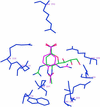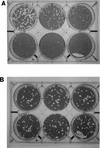Generation and characterization of a mutant of influenza A virus selected with the neuraminidase inhibitor BCX-140
- PMID: 9559786
- PMCID: PMC105545
- DOI: 10.1128/AAC.42.4.801
Generation and characterization of a mutant of influenza A virus selected with the neuraminidase inhibitor BCX-140
Abstract
Influenza neuraminidase (NA) plays an important role in viral replication, and characterization of viruses resistant to NA inhibitors will help elucidate the role of active-site residues. This information will assist in designing better inhibitors targeted to essential active-site residues that cannot generate drug-resistant mutations. In the present study we used the benzoic acid-based inhibitor BCX-140 to select and characterize resistant viruses. BCX-140 binds to the NA active site in an orientation that is opposite that of a sialic acid-based compound, 4-guanidino-2,4-dideoxy-2,3-dehydro-N-acetylneuraminic acid (GANA). Thus, the guanidino group of BCX-140 binds to Glu-276, whereas in GANA the guanidino group binds to Glu-119. We passaged influenza A/Singapore/1/57 (H2N2) in Madin-Darby canine kidney cells in the presence of BCX-140, and virus resistant to this inhibitor was selected after six passages. The NA of this mutant was still sensitive to inhibition by BCX-140. However, the mutant virus was resistant to BCX-140 in plaque and 3-(4,5-dimethylthiazol-2-yl)-2,5-diphenyltetrazolium bromide (MTT) assays. Sequence analysis of hemagglutinin (HA) and NA genes revealed changes in both, although none were in the active site of the NA. Depending on the method of selection of the resistant virus, two types of changes associated with the sialic acid binding site were seen in the HA. One is a change in HA1 of Ala-133 to Thr, a residue close to the binding site, while the other change was Arg-132 of HA1 to Gln, which in HA1 of serotype H3 is a sialic acid contact (Asn-137). Binding studies revealed that both types of resistant viruses had reduced receptor binding affinity compared to that of the wild type. Thus, resistance to BCX-140 was generated by modifying the HA. NA active-site residue 276 may be essential for activity, and thus, it cannot be changed to generate resistance. However, drug-induced changes in the HA can result in a virus that is less dependent on NA activity for growth in cells and, hence, resistant to NA inhibitors.
Figures





References
-
- Air G M, Els M C, Brown L E, Laver W G, Webster R G. Location of antigenic sites on the three-dimensional structure of the influenza N2 virus neuraminidase. Virology. 1985;145:237–248. - PubMed
-
- Bean W J, Threlkeld S C, Webster R G. Biologic potential of amantadine-resistant influenza A virus in an avian model. J Infect Dis. 1989;159:1050–1056. - PubMed
-
- Colman P M, Varghese J N, Laver W G. Structure of the catalytic and antigenic sites in influenza virus neuraminidase. Nature (London) 1983;303:41–44. - PubMed
-
- Grambas S, Bennett M S, Hay A J. Influence of amantadine resistance mutations on the pH regulatory function of the M2 protein of influenza A viruses. Virology. 1992;191:541–549. - PubMed
Publication types
MeSH terms
Substances
Grants and funding
LinkOut - more resources
Full Text Sources
Other Literature Sources
Research Materials

